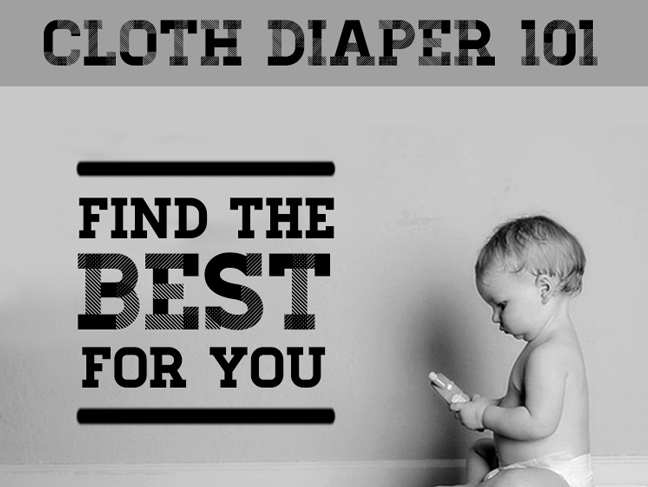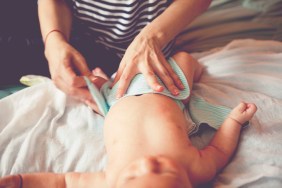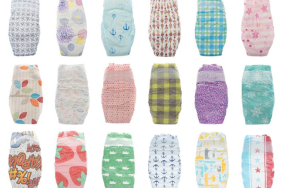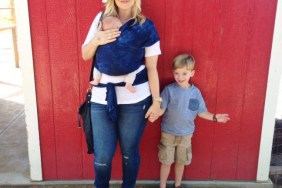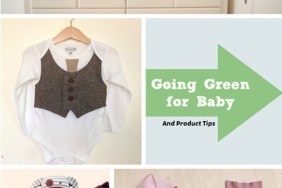
Cloth diapers today aren’t like they used to be. Your grandmother’s pins and rubber pants have been replaced by easy-to-use all-in-ones with adorable prints and lots of styles. But as great as it is to have so many eco-friendly options, navigating the choices can get a little confusing. If your decision between prefolds and pockets is feeling as complicated as choosing your baby’s name, let us help you figure out your options. Welcome to Cloth Diapering 101.
Types of Diapers
There are four major types of cloth diapers to choose from. Which one is best for you depends on whether you’re looking for cost-effective, convenient, or a blend of the two.
1. Prefolds/Flats and Covers
This two-part system is the updated version of the diapers your grandmother used. It consists of two parts: an absorbent inner layer and a waterproof cover. The inner layer is usually a cotton cloth; bamboo and hemp are also options. If you want a budget-friendly option, you can even use material you already have—old T-shirts or hand towels will both work great as diapers in a pinch.
Even if you choose high-quality prefolds for your absorbent layer, this type of diaper is the least expensive, mostly because you can reuse covers for multiple changes. You’ll change the absorbent layer every time your baby wets, but you can keep using the waterproof covers for a day or two unless they’re smelly or visibly dirty. That means you can get by with only a few covers (4–6 is usually plenty) along with a good collection of prefolds or flats (24 is the minimum number for a newborn).
The downside of this method? It’s the most complicated to learn. Flats are simply large, flat pieces of cotton, so to use them as a diaper, you’ll need to learn a little diaper-folding origami. Prefolds are sewn with a thicker area down the middle, but you’ll still need to fold them a little to shape them into a functional diaper. But don’t let that intimidate you: it’s diaper folding, not rocket science.
Once you’ve got the inner absorbent layer figured out, you’ll need to add a waterproof cover. Most covers are made of PUL—a breathable type of plastic cloth that’s thin and flexible. You can also choose fleece (thicker but more breathable) or wool (very breathable and absorbent, but requires special care in cleaning).
Finally, you’ll need to decide what type of closure you want for the covers: hook-and-loop (just like velcro: easy to adjust, but also easy for bigger babies to pull of themselves), front snaps (very secure and long-lasting, but less flexibility in size), or side snaps (secure, trim look that’s great for chunky babies).

Advantages: inexpensive, lots of options, easy to adjust absorbency
Disadvantages: have to fold, bulky
2. Fitteds/Contours and Covers
This system is exactly like prefolds, but without the folding. Fitteds are absorbent material shaped into a diaper, complete with closures (again, you can choose between hook-and-loop or snap). They’re made of cotton, bamboo, hemp, synthetic materials, or blends, and they come in prints and colors as well as plain white. As with prefolds, you’ll need about 24 fitteds with 4–6 covers.
Contours are essentially fitteds that don’t have any type of closure. They’re a piece of absorbent material sewn into a contoured shape that fits into a cover. You can place the contour in the cover and then put the entire diaper onto your baby in one piece.

Advantages: simple to use, inexpensive
Disadvantages: bulky
3. Pockets
If you’re looking to combine ease of use with flexibility, it’s hard to improve on a pocket diaper. Pockets consist of two parts: a diaper that includes both an inner wicking layer and a waterproof outer layer with a pocket opening between them, and an absorbent insert. To use a pocket, you stuff the insert into the pocket and then put the diaper on your baby. Unlike prefolds, pockets require you to wash the entire diaper (including the outer cover) at every change. However, the pocket opening means you can easily adjust the absorbency of the diaper to fit your needs: use a thin microfiber insert during the day for a trim look, and add a couple of hemp inserts for overnight.
Pockets are also convenient for babysitters: after you’ve stuffed the insert, putting a pocket on is exactly like putting on a disposable, with no folding or special knowledge required.
Most pockets have an outer PUL layer, but you can also get fleece or wool. The inner layer is usually microfleece, which wicks moisture away to keep your baby comfortable, but you can also choose bamboo, hemp, or cotton. Inserts are generally made of microfiber, a super-absorbent synthetic material, but cotton, hemp, and bamboo are also options.
Pockets come in dozens of prints and colors, and closure can be hook-and-loop, front snap, or side snap.

Advantages: easy to use, adjustable
Disadvantages: more expensive, have to stuff inserts
4. All-in-Ones
If you hesitate to choose cloth because of the convenience of disposables, then all-in-one diapers are your answer. Just as the name implies, all-in-ones include the entire diaper in a single piece. The waterproof layer, the absorbent layer, and the wicking layer are all sewn together, which means that using an all-in-one is every bit as simple as using a disposable. There’s no stuffing, no folding, and no confusion—just put it on and take it off. The only difference from a disposable is that you toss the dirties in a laundry pail instead of the trash.
As with other types, there are many options for materials and colors, and closures can be hook-and-loop, front snap, or side snap.

Advantages: easy to use
Disadvantages: most expensive, hard to adjust absorbency
Materials
Your choice of materials depends on function, form, and personal style.
1. Inner Layer
The inner layer can be wicking or absorbent. If you want your baby to feel comfortable and mostly dry between changes, go for a wicking material like microfleece. If you want your baby to feel the wetness (a big advantage as you get close to potty training age), you may want a material that feels wet like cotton or bamboo. You can also opt for minky, a super-soft type of material that toddlers love. If allergies run in your family, you may want to look for all-natural, organic materials like organic cotton and hemp.
2. Outer Layer
There are three major choices for your diaper’s outer layer: PUL, fleece, and wool.

PUL, or polyurethane laminate, is made of a layer of cotton fabric and a layer of plastic that’s melted to the fabric. It’s very thin and breathable, and it can be made in a variety of colors and prints. However, because the manufacturing involves a chemical process, some families prefer to opt for more natural materials.
Best for: trim coverage under cute clothes
Polyester fleece is more breathable than PUL, so if your baby tends to get rashes, it might be your best option. Like PUL, it can be washed and dried in your machines along with the rest of your diaper laundry.
Best for: inexpensive breathability
Wool is a favorite choice for ultra-eco-friendly families. It’s naturally absorbent, and when treated with lanolin, it becomes incredibly waterproof. It’s also antibacterial and odor-resistent, so you can often reuse it longer than other types of covers. The only disadvantage is that it requires special care when cleaning—it’s best to wash by hand, re-lanolize regularly, and lay flat to dry. It’s also more expensive than the other options, but you can find very affordable options on Etsy made from upcycled wool sweaters.
Best for: overnight, breathability, all-natural fibers
Ready to pick the cloth diaper best for you and baby? In case you’re still a little confused (I know I was!), we made this infographic to help summarize the cloth diaper types above. Use this cloth diaper finder for help picking the best cloth diaper maker for you.
And once you know what you want, all you need to do is add it to your BabyList registry!
More Baby Articles:
